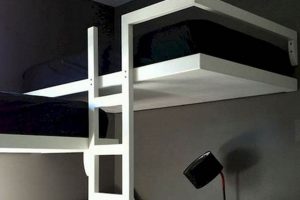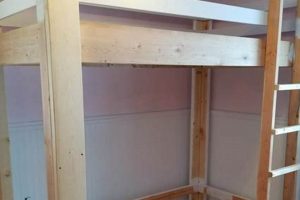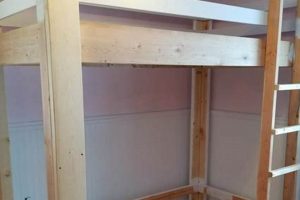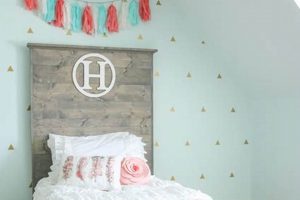Creation of personalized bed linens, covers, and related items through individual effort is increasingly prevalent. This method allows for the tailoring of materials, dimensions, and aesthetics to specific needs and preferences. For example, an individual might sew a duvet cover from reclaimed fabric, or construct a bed skirt using a favored textile.
Self-made sleep environments offer numerous advantages. Economically, they can present a cost-effective alternative to commercially available products. From an environmental standpoint, repurposing fabrics and minimizing waste aligns with sustainable practices. Historically, crafting items for the home was a common necessity, preceding mass production. Today, this practice provides a sense of ownership and creative fulfillment.
The following sections will delve into specific techniques for constructing custom bed linens, exploring available fabric options, and providing practical advice for achieving professional-quality results in home-based projects.
Tips for Creating Personalized Sleep Environments
Achieving desirable results in self-made bed linen projects requires attention to detail and careful planning. The following tips offer guidance for producing high-quality, durable, and aesthetically pleasing bedding.
Tip 1: Fabric Selection. Choosing the appropriate fabric is paramount. Consider thread count, fiber content (e.g., cotton, linen, silk), and intended use. Higher thread counts generally indicate greater durability and softness. Pre-washing fabric is critical to prevent shrinkage after the bedding is complete.
Tip 2: Accurate Measurements. Precise measurements of the mattress and existing bedding are essential for achieving a proper fit. Account for seam allowances and desired drape when calculating fabric requirements. A well-fitted sheet or duvet cover significantly enhances both comfort and appearance.
Tip 3: Seam Reinforcement. Given the stress placed on bedding seams during use and laundering, reinforcement is crucial. Employ techniques such as French seams or serged edges to prevent fraying and increase durability. Topstitching along seams adds strength and a professional finish.
Tip 4: Corner Construction. Mattress corners require specific attention. Mitered corners or fitted sheet corners with elastic casings provide a secure and tailored fit. Careful construction of these areas minimizes slippage and ensures a smooth, comfortable sleep surface.
Tip 5: Zipper and Button Placement. When incorporating closures such as zippers or buttons, consider accessibility and aesthetics. Use high-quality fasteners and reinforce the surrounding fabric to prevent tearing. Invisible zippers provide a seamless appearance for duvet covers and pillow shams.
Tip 6: Pattern Matching. For patterned fabrics, careful matching at seams and closures elevates the overall design. This requires additional fabric and meticulous cutting, but results in a more cohesive and professional-looking finished product.
Tip 7: Proper Ironing. Ironing fabric before cutting and sewing, as well as the finished bedding, contributes to a crisp, polished appearance. A well-pressed item also facilitates accurate cutting and sewing, minimizing errors and improving the final outcome.
By adhering to these guidelines, individuals can create personalized sleep environments that are both functional and visually appealing, reflecting their unique style and preferences.
The subsequent section will explore common challenges encountered in crafting personalized bed linens and offer solutions for overcoming these obstacles.
1. Fabric Selection
Within the context of personalized bed linen creation, fabric selection is a foundational element that determines the final product’s comfort, durability, and aesthetic appeal. The choice of material is not merely a surface-level decision; it is intrinsically linked to the success and longevity of the bedding. Inadequate fabric selection can result in discomfort, rapid wear, or an undesirable appearance, thereby negating the benefits of individual creation. For instance, utilizing a loosely woven cotton for a fitted sheet may lead to premature tearing and loss of shape, requiring frequent replacement. Conversely, selecting a high-quality, tightly woven linen or cotton percale ensures breathability, durability, and a luxurious feel against the skin.
The connection extends to practical considerations such as ease of maintenance. A fabric like polyester microfiber may offer stain resistance and wrinkle reduction, appealing to those seeking convenience. However, it may lack the breathability of natural fibers, potentially leading to discomfort in warmer climates. Similarly, a complex, heavily embroidered fabric, while visually striking, may require specialized cleaning methods, increasing the long-term cost and effort of upkeep. Therefore, informed decisions about fabric type, weight, and weave are paramount. Consider the intended use, climate, personal preferences, and maintenance requirements when making the final selection. A carefully chosen fabric serves as a testament to the crafter’s understanding of the material’s impact on the finished bedding.
Ultimately, the fabric chosen dictates the overall quality and user satisfaction of custom bed linens. The selection process requires thorough consideration of performance characteristics, maintenance needs, and aesthetic goals. Overlooking this crucial step risks compromising the entire project, resulting in bedding that fails to meet expectations or withstand regular use. Prioritizing informed fabric selection establishes a strong foundation for successful and enduring personalized sleep environments.
2. Precise Measurement
Accurate dimensioning is a foundational element in the crafting of personalized bed linens. The success of such projects hinges critically on the precision with which measurements are taken and applied, influencing both the fit and aesthetic of the final product.
- Mattress Dimensioning
The dimensions of the mattresslength, width, and depthare the starting point for all bedding measurements. Inaccurate measurement of these parameters directly affects the fit of fitted sheets, mattress protectors, and bed skirts. For instance, an underestimated mattress depth will result in a fitted sheet that consistently slips off, while an overestimated dimension can lead to excess fabric and a sloppy appearance. Correct mattress dimensioning ensures a snug, secure fit that enhances comfort and prevents premature wear.
- Duvet and Comforter Sizing
Duvet covers and comforter dimensions must correspond accurately to the size of the insert. Standard sizing charts can provide a general guide, but variations between manufacturers necessitate individual measurement. An undersized cover will compress the filling, reducing loft and warmth, while an oversized cover can lead to shifting and uneven distribution of fill. Precise measurements guarantee a visually appealing and functionally optimized duvet or comforter.
- Pillowcase and Sham Dimensions
Pillowcases and shams are primarily decorative, but their dimensions still demand precision. Variations in pillow size necessitate custom dimensions for a tailored appearance. A poorly sized pillowcase can result in bulging or sagging fabric, detracting from the overall aesthetic of the bedding ensemble. Careful measurement ensures a smooth, wrinkle-free appearance that complements the other elements of the sleep environment.
- Seam Allowance Consideration
Accurate calculation of seam allowances is crucial for achieving the intended final dimensions. Consistent seam allowances contribute to the overall symmetry and structural integrity of the bedding. Failure to account for seam allowances can result in undersized or misshapen components, requiring rework and potentially wasting fabric. Meticulous attention to seam allowance ensures a professional finish and accurate adherence to the desired design.
The accuracy of these measurements directly impacts the comfort, appearance, and longevity of the customized bedding. Neglecting precision in dimensioning can lead to suboptimal results, undermining the benefits of personalized creation. Therefore, meticulous attention to measurement is paramount in achieving a successful and satisfying outcome.
3. Seam Construction
Seam construction is a critical element in the production of durable and aesthetically pleasing custom bed linens. The manner in which fabric pieces are joined directly impacts the longevity, structural integrity, and overall appearance of items such as duvet covers, pillowcases, and fitted sheets. Weak or poorly executed seams are prone to failure under the stresses of regular use and laundering, resulting in premature wear and requiring costly repairs or replacements. For example, a simple straight stitch on lightweight cotton, while expedient, may unravel quickly at the corners of a pillowcase, necessitating frequent re-stitching. Conversely, a reinforced seam, such as a French seam or a flat-felled seam, provides superior strength and a clean, finished edge, significantly extending the lifespan of the bedding.
The choice of seam construction technique should align with the type of fabric being used and the intended application. Heavier fabrics, such as denim or canvas, may require serged edges and reinforced seams to withstand significant stress. Lighter fabrics, like silk or voile, necessitate delicate seam finishes to prevent puckering or distortion. The use of appropriate thread and needle types is equally important. Using a fine needle with a heavy thread can damage delicate fabrics, while a weak thread may break easily when used on heavier materials. Furthermore, seam allowances must be consistent and accurately measured to ensure a proper fit and prevent puckering or distortion along the seams. The meticulous application of these principles results in bedding that not only looks professional but also withstands the rigors of daily use.
In summary, seam construction is a key determinant of quality and durability in handmade bed linens. Appropriate selection of seam type, thread, needle, and consistent seam allowances are essential for creating bedding that is both aesthetically pleasing and structurally sound. By prioritizing careful seam construction, individuals can ensure that their creations not only reflect personal style but also provide long-lasting comfort and satisfaction. Neglecting this aspect can lead to inferior results and negate the potential benefits of creating custom bed linens.
4. Corner Detailing
In the realm of personalized bed linen creation, corner detailing significantly influences the final product’s fit, function, and visual appeal. The manner in which corners are constructed directly impacts the way fitted sheets adhere to mattresses, the drape of bed skirts, and the overall tailored appearance of bedding ensembles. Poorly executed corners result in ill-fitting linens, creating discomfort and detracting from the intended aesthetic. For instance, inadequately mitered corners on a bed skirt will appear uneven and unprofessional, while poorly secured elastic casings on fitted sheet corners lead to slippage and require frequent adjustment. Conversely, carefully constructed corners contribute to a secure, smooth fit and an elevated visual presentation. This meticulous attention to detail differentiates bespoke creations from mass-produced alternatives.
Specific corner techniques demonstrate the practical implications of corner detailing. Fitted sheets, for example, often employ either traditional mitered corners or elastic casings. Mitered corners require precise stitching and accurate fabric calculations to achieve a snug fit, offering a clean, tailored look. Elastic casings, while easier to construct, demand high-quality elastic and secure stitching to prevent premature stretching or detachment. Bed skirts often utilize box pleats, knife pleats, or gathered designs at the corners, each demanding careful measurement and precise construction to maintain symmetry and ensure a uniform drape. The choice of corner detailing technique should align with the chosen fabric, the desired aesthetic, and the level of skill of the individual undertaking the project. Attention to these elements contributes to the creation of durable and visually appealing personalized bed linens.
In summary, corner detailing is a critical component of personalized bed linen construction, impacting both the functionality and aesthetic appeal of the finished product. Mastering various corner techniques and selecting appropriate methods based on fabric and design considerations are essential for achieving professional-quality results. Proper execution ensures a secure fit, enhances visual appeal, and contributes to the longevity of self-made bedding, solidifying its position as a defining element in the realm of bespoke sleep environments.
5. Closure Integrity
Within the sphere of do-it-yourself bed linen projects, closure integrity is a paramount consideration. The reliability and durability of closures, such as zippers, buttons, snaps, and ties, directly influence the functionality, longevity, and aesthetic of the finished bedding. Compromised closures render bedding unusable, detract from visual appeal, and necessitate repair or replacement, thereby negating the intended benefits of self-creation.
- Zipper Selection and Application
The selection of appropriate zippers is critical. Heavy-duty zippers are necessary for duvet covers and other items subjected to significant stress. The zipper must be properly installed, with reinforced stitching around the zipper tape to prevent tearing. Improper installation or the use of lightweight zippers will lead to premature failure, compromising the enclosure and necessitating replacement.
- Button Security and Placement
Buttons used on pillow shams or decorative closures require secure attachment to withstand repeated use and laundering. Buttonholes must be appropriately sized and reinforced to prevent fraying. The placement of buttons should be strategic, ensuring ease of use while maintaining the desired aesthetic. Loosely attached buttons or poorly constructed buttonholes are susceptible to detachment, diminishing the bedding’s overall appearance and functionality.
- Snap Fastener Reliability
Snap fasteners offer an alternative closure method, particularly for smaller items or decorative elements. High-quality snaps, correctly installed with appropriate tools, provide a secure and reliable closure. Inadequate installation or the use of inferior snaps results in frequent detachment, rendering the closure ineffective and potentially damaging the surrounding fabric.
- Tie Cord Durability and Securement
Tie closures, often used for duvet covers or decorative accents, require durable cords and secure attachment methods. The cords must be resistant to fraying and breakage, and the points of attachment to the fabric must be reinforced. Weak cords or poorly secured attachment points lead to detachment, compromising the enclosure and necessitating repair or replacement.
The consistent thread connecting these facets is the integral role closure integrity plays in the overall success of DIY bedding projects. Investing in high-quality materials and employing robust construction techniques are crucial for ensuring the longevity and functionality of personalized bed linens. Compromised closures not only detract from the visual appeal but also diminish the practical value, thereby underscoring the importance of prioritizing secure and durable closure methods.
6. Aesthetic Harmony
Within the realm of self-created bed linens, aesthetic harmony transcends mere visual appeal; it represents a cohesive integration of design elements to cultivate a balanced and pleasing sleep environment. This harmony is not an accidental occurrence but a deliberate orchestration of color, pattern, texture, and form. Achieving it elevates custom bedding from functional textiles to integral components of personal expression and comfort.
- Color Palette Cohesion
The selection of a unified color palette is fundamental to achieving aesthetic harmony. Color impacts mood and influences perception of space. A carefully chosen palette, whether monochromatic, analogous, or complementary, establishes a visual foundation for the entire bedding ensemble. For instance, using various shades of blue and gray creates a calming, serene atmosphere, while incorporating muted earth tones evokes warmth and tranquility. In contrast, discordant color combinations can disrupt the visual equilibrium, leading to a sense of unease or visual clutter. Therefore, deliberate color selection is paramount.
- Pattern Scale and Coordination
Pattern plays a significant role in defining the character of bed linens. The scale of the pattern, whether large or small, should be proportionate to the size of the bed and the overall dimensions of the room. Furthermore, coordinating multiple patterns requires careful consideration. Mixing patterns of similar scale and style can create a cohesive look, while juxtaposing contrasting patterns introduces visual interest. For example, pairing a small-scale floral print with a larger geometric pattern can add depth and complexity without disrupting the visual balance. An imbalance in pattern scale or clashing styles can detract from the overall aesthetic.
- Textural Variation and Balance
Introducing textural variation enhances the tactile and visual interest of bed linens. Combining smooth fabrics like silk or satin with more textured materials such as linen or velvet adds depth and dimension. Balancing these textures is essential to prevent sensory overload. For example, incorporating a velvet accent pillow into a bedding ensemble primarily composed of smooth cotton percale adds a touch of luxury and warmth without overwhelming the senses. Conversely, an excessive use of heavily textured fabrics can create a visually busy and uncomfortable sleep environment.
- Proportional Balance and Arrangement
The arrangement of bed linens and accessories contributes significantly to aesthetic harmony. The proportional balance of elements, such as pillows, blankets, and throws, influences the overall visual equilibrium. Creating a sense of symmetry or deliberate asymmetry adds visual interest while maintaining a cohesive aesthetic. For instance, arranging pillows of varying sizes and shapes symmetrically along the headboard creates a sense of order and balance. Conversely, a haphazard arrangement of elements can disrupt the visual flow and detract from the intended aesthetic.
These facetscolor, pattern, texture, and arrangementcollectively contribute to the creation of aesthetically harmonious personalized bed linens. By thoughtfully orchestrating these elements, individuals can craft sleep environments that not only reflect their personal style but also promote a sense of calm and well-being. Neglecting these considerations results in a fragmented and visually unappealing outcome, underscoring the importance of deliberate design choices in achieving aesthetic harmony in the context of self-made bedding.
7. Durability Focus
The success of individualized bed linen projects is inextricably linked to a deliberate focus on durability. The inherent value proposition of crafting custom bedding lies in the potential for long-term use and cost-effectiveness. Neglecting the principles of durability in fabric selection, construction techniques, and reinforcement strategies directly undermines this proposition. For instance, a duvet cover sewn with weak seams from a low-thread-count fabric will likely succumb to wear and tear within a short period, necessitating replacement and negating any initial cost savings. Conversely, utilizing high-quality materials, employing reinforced seams, and incorporating durable closures result in a bedding ensemble that withstands the rigors of frequent laundering and prolonged use. The practical significance of this understanding is evident in the long-term value and reduced environmental impact of durable, self-made bedding.
The connection between durability and DIY bedding extends to the selection of appropriate construction methods. Employing French seams, flat-felled seams, or serged edges enhances the structural integrity of seams, preventing fraying and unraveling. Reinforcing stress points, such as corners and closure attachments, further contributes to longevity. For example, adding extra stitching around buttonholes or reinforcing zipper attachments on duvet covers significantly reduces the risk of failure. A real-life example is a hand-stitched quilt passed down through generations, showcasing the enduring nature of durable construction techniques. The practical application of these methods ensures that DIY bedding maintains its integrity over time, providing sustained comfort and aesthetic appeal.
In summary, a conscious emphasis on durability is essential for realizing the full potential of personalized bed linen creation. Fabric selection, construction techniques, and reinforcement strategies are all critical components in achieving long-term value and reducing the environmental impact associated with frequent replacements. While initial material costs may be higher for durable options, the long-term benefits in terms of longevity, reduced maintenance, and sustained aesthetic appeal far outweigh the initial investment. Overcoming the temptation to compromise on quality for short-term cost savings is crucial for ensuring that DIY bedding projects provide enduring satisfaction and tangible value.
Frequently Asked Questions Regarding Self-Made Bed Linens
This section addresses common inquiries and misconceptions surrounding the creation of personalized bedding, providing detailed responses to assist individuals in making informed decisions.
Question 1: Is the creation of personalized bed linens economically viable compared to purchasing commercially produced alternatives?
The economic viability of self-made bedding hinges on several factors, including fabric costs, required tools, and the value placed on personal labor. While initial material expenses may approximate or exceed the cost of mass-produced items, the ability to customize dimensions, fabric types, and design elements offers distinct advantages. Furthermore, the longevity of well-constructed self-made bedding can surpass that of commercially available options, potentially resulting in long-term cost savings.
Question 2: What level of sewing proficiency is required to undertake a bed linen project?
The necessary sewing skill level varies depending on the complexity of the project. Simple projects, such as pillowcases or basic fitted sheets, require only fundamental sewing skills. However, more intricate endeavors, such as duvet covers with intricate closures or tailored bed skirts, necessitate advanced techniques and experience. Individuals with limited sewing experience are advised to begin with simpler projects and gradually progress to more challenging undertakings.
Question 3: What types of fabrics are best suited for bed linen construction?
The optimal fabric choice depends on factors such as desired comfort, durability requirements, and maintenance considerations. Natural fibers, such as cotton, linen, and silk, offer breathability and comfort, while synthetic fabrics, such as polyester microfiber, provide wrinkle resistance and stain resistance. Higher thread counts generally indicate greater durability and softness. Pre-washing fabrics before construction is essential to prevent shrinkage.
Question 4: What are the primary challenges encountered in creating self-made bed linens, and how can they be mitigated?
Common challenges include achieving accurate measurements, ensuring consistent seam allowances, and preventing fabric puckering. Meticulous attention to detail, precise cutting techniques, and the use of appropriate sewing machine settings can mitigate these issues. Employing techniques such as French seams or serged edges enhances seam durability and prevents fraying.
Question 5: How can the lifespan of self-made bed linens be maximized?
Maximizing longevity requires a multi-faceted approach. Using high-quality fabrics, employing reinforced seams, and following proper laundering instructions are essential. Avoiding harsh detergents and excessive heat during washing and drying can prevent premature wear and fading. Regularly inspecting and repairing minor damage, such as loose seams or frayed edges, can extend the lifespan of the bedding.
Question 6: What are the potential environmental benefits of creating personalized bed linens?
Self-made bedding offers several potential environmental advantages. Repurposing existing fabrics reduces textile waste and minimizes the demand for new resources. Selecting organic or sustainably produced fabrics supports environmentally responsible manufacturing practices. Crafting durable, long-lasting bedding reduces the need for frequent replacements, further minimizing environmental impact.
In summary, the creation of personalized bed linens presents both economic and environmental considerations. With thoughtful planning and careful execution, customized bedding can provide substantial benefits.
The following section will delve into specific resources and tools available to assist in the successful creation of custom bed linens.
Conclusion
This exploration of “diy bedding” has underscored the multifaceted nature of this craft. From fabric selection and precise measurement to seam construction, corner detailing, closure integrity, aesthetic harmony, and a concentrated focus on durability, each element contributes to the successful creation of personalized sleep environments. The economic and environmental considerations associated with the endeavor have been addressed, alongside common challenges and strategies for mitigation. The preceding frequently asked questions provide further clarity and guidance.
The information presented herein advocates for a thoughtful and informed approach to “diy bedding.” It is imperative to recognize the potential benefits, acknowledging the effort required to achieve high-quality results. Continued refinement of techniques and exploration of sustainable practices within this craft can further enhance the value and appeal of self-made bedding, establishing it as a viable and responsible alternative to mass-produced options. Readers are encouraged to apply this knowledge judiciously, fostering both personal creativity and environmental stewardship.







